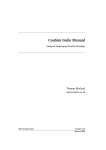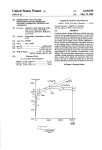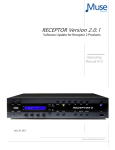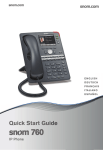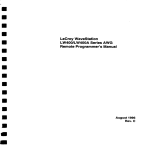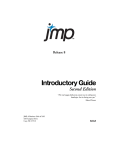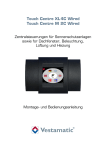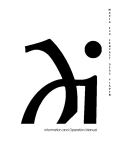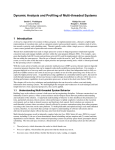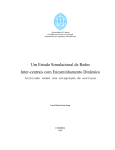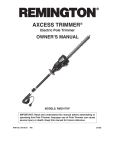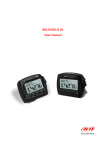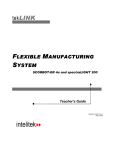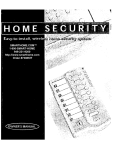Download The Fairlight explained
Transcript
TIf,E E'ATRTTGIIg
EXPEATSUED
When the Fairlight CMI was released seven years dgo, both the machine
and its software represented a significant step forward in the application
of computer technology to music. Today, the Fairlight is used in the
rnaking of popular music the world over, as well as performing an important
role in the field of musical and technological education. Despite this, very
few people are fully aware of what the CI}II does and how it does it. Jim
Grant, who's been working with one for a number of years at the London
College of Furniture, has decided to rectify matters by writing a series
dedicated to explaining the Fairlight's workings. Part one appears below.
E & MM
AUGUST19 84
efore the Fairlight'sappearance,
most computer music systems
were the perogativeof mainframes
and th e i r c ont r ibut iont o th e w o rl d o f
everyday music was slight. Kim Ryrie
(the Fairlight'sfather)and his Australian
colleaguessoon changedall that, however and their inventionis now used in
almost area of music production,to the
extent that many people appreciateits
sound without realising that they're
lis te n i n gto ' m us ic by num b e rs ' .
However,despiteits widespreaduse,
thereare relativelyfew Fairlightsin general
.100
circulation- less than
in the UK and to see one in actionat close quarters
is a realtreat.Hereinliesthe rationalefor
this series of articles.What does the
Fairlightdo? How does it do it? And
what can the averagemusiciando with
it ?
0r , 1il8N n
Software
A foolproof system of connectorsand a quick glanceat the manualon the
part of the user- ensuresthat the Fairlight
can be powered up in no more than five
minutes.The VDU displaysthe expectant
m e ssa g e' CM l RE A DY ' ,w h i l e th e C PU
hums quietly:thereare threefans pulling
air throughthe innards,keeping500 watts
of power dissipationdown to an acceptabl e te mp er at ur e. . . .
lnsertingthe Systemsdisk in the lefthand drive(Drive0) resultsin a faintclick
as the stepper motors engage. The
operating software is loaded as a series
of 'fetches'- each section of program
loaded pulls in the next section.When
this process has been completed,the
user is faced with the Index page. See
F i g u re1 .
Here lies one of the Fairlight'smost
powerfulfeatures.The whole system is
menu-drivenand the differentoptions
correspond to different VDU displays
and sets of commandswhich are entered
from the alphanumerickeyboard.Each
option is referredto as a Page. A Page
has one or more files resident9n the
Systemsdisk which are loadedwhenthe
Page is selected. Page 1 is the Index
Menu itself (Figure 1), while Page 2
managesthe files stored on the disk in
the right-handdrive(Drive1).Thesefiles
are user-created, and there are seven
differenttypes, as indicatedby the suffix
afterthe file name.Theseare as follows:
NAME.VCis a voicefileoccupyingabout
2OkBytes.lt holds waveform data (1610
and extra informationregardinglooping
and so on.
NAME.CO holds control information
such as portamento,vibrato frequency
and depth.
28
rnbL
<
rNbL
J
PRGE4
PIi|jE 5
f
I|1 IRLI [ HT
n l - 'L
b
PBriE 7
P R I J ED
PFDE S
PH6E FI
PBl]E [,
PFEE D
PBriE L
PrirlE R
I l,l.I
u3 , t 5 , Rl , l l
TN b L
5
I.JS E R N FI14E, J I l l
Hardware
To take deliveryof a Fairlightleaves
your bank balanceempty and your living
room full. The hardwareconsists of a
Central ProcessorUnit (CPU),one - or
optionallytwo - six-octavekeyboards,a
typewriter-styleQWERTYkeyboard,and
a VDU with added lightpen.ln addition,
there are some long connectingleads,a
Systemsfloppy disk drive and a box of
disks containinglibrarysounds.
INDEX
DISK DONTROL
K E Y B D H R DC O N T R c l L
I I I I R I '1 OI C
N ENUELDPES
I , I E U E F O RE
I l E N E R B ITO N
I , I H U E F I ] R I I'1
R f i I ,I IN C
c c | N T R | | LP F R R I l E T E R S
S | J U N DS R I l P LI t I | ]
SEUUENDER
f f N f f L O GI N T E R F H I E
C O I 'I P O S E R
l , I H U E F O RD
HI S P L F I Y
DI S K L I B R F R Y
R E R L - TI I l E C D 1 4 P | ] S E R
S C R E E NP RI N T
P IID E I
DRRNT
l@t
011f lf f t i D '
DI SK, E X E I l P L E
USER. J I T '1G R f l N T
1 I NU E N T . I N
I6
2llit r I lE r m
t7
3 PRE L U D E, I N
I8
4 UI U F L D I , I I I
I9
5 Bf iS S G T . U C ? B
6 BDD 2
UC 2I
7 CBE L L O ( ] [ U
} C E2
8 G RN G S R U C 2 3
S STIC K
.UC 24
1B STR I I'ID
UC 25
UC 28
11 I f r N N
T2 ERS S G T C O 2 7
13 BBD z . .
.C0 28
14 CBE L L O O O . C O2 9
I 5 G RN G S R . C O 3 6
FREE SPHCE.
LIBRffRY NO.
STIDK
C|]
ItiuENT .S0
P R E L U D E. S O
UIURLDII.SO
LOCUST .RS
PBGEI
.PX
PFGEz
.PX
PFGES
,PX
SYHTH
.PC
SYNTH
. PT
BFSSD
.SS
CNTRL
.SS
.SS
SN3
TUHEl
,SS
TUNEz
,SS
I l U L TI
TRBNS F E R
536
8
DELETE
EUERY
!.qgH$I .,-l|:| .tvee:-ln$IRU|]1ENi
v o i c e s 'B D D 2
STICK
clt r
CIi N D EL
EII
tlcL
, 24. .
.,, ,ye| l, ..:i,,r,e
BFSSGT
STR|4
ID
T
l@
Com'irter
rcthsb@rd
Address
bus
Cmlfol
crrcurlry
wovelorm RAM
dio signol
oulpui
AUGUST1984
E&MM
IfIIiIIEIIIIE
and types
F fim
SPRCE o n d isk
lfnfilfli$
number
{ t4 UL T I & C B N C E L)
EfiffilflIn
tile s
flllffiE
u se n o r f i ]e nenret
d isk,
co m m a n d
EIIfII
fi l es
EN:III| IE in stn u m e n t
o n vo ir e
f ile s
m l!fiflIn
in str u m e n t
I[ll| ifflE
vo ice
f ile s
]m :filfln
f ile s
sEq u e n ce
|lJifllfll
somnrend
If#IIEiIfE
cor'mahd
pnotect
nFffiff:dmftfmlfi
i on
Im m L Ef0 o r r m tsste r k e yb o sr d
m fiil:Im
sh o r tcu ts
2
sheet,
3
3.
3
4
c
f
6
b
7
6
I
1 8,
it
toucn
sny
l0 X
r ^ r ith L IGHT PEN o r
t ouc h lI f f i
type,
u h erE :
or t vP e '
n(set)
=
n
sneel
HI ( n e t u r n )
Pa g e2 Co m m a n ds
EE!tr4
TRfiNSFER FILES
T O BNOT H
,
YPE.
L I GHTPEN
(select
files)
T,file (retu nn )
<T R f i N S F E R )
or
T, f ile, f ile, l ile( , .
. et c ) ( r et ur n)
= FiLENEI I E SF or
r,rhene , file
* * - *l
or
I
f*
or
(s s m e as DELETE; s ee abov e)
E X RI'4PL ES, T. CH0RUS,I N( r et unn)
T, 4-1 8, FBLE. UC,2S( net ur n)
F i Ies u i I I b e copied FR0l' 1dis k in RH dniv e ( D I S K f i ) T 0 a n o t h e n
G iv e TRRNSF E Rc o t n m a n du i t h s v s t e m
disk in LH d nive ( DI SK B) .
l,lhen the messaEe'
disk in LH d nive and DI SK R in RH dr iv e.
PL RCE FI LE DI SK I N LH DRI U E
l, lhen t h e t n a n s f e r
is
E pp €tsFS, p lace D I SK B in LH dr iv e.
m es s age r r i I I neques t t h e r e p l a c e m e n t o f t h e
cornple ted a fin al
If a f ile
alneEdy ex is t s on D I S K E ( h a s s e m E
system d isk.
N0T be ovenunitten
name a nd suf f ix as f ile on DI SK R) , it ui l l
you n con s ent . See als o
PROTECTION.
wit ho ut
TYPE, T, t ( net ur n)
l,lhe n the me ssege eppeEr s plac e a EEI I t r f i 1 e d i s k i n L H d r i v e .
Ne r *rd i s k u i I I u s u a l l y
R epla ce syste m dis k r , r hen c om Plet ed.
shor.r an incne ase in FREE SPFCE av ai lable
@
NAME.INconfiguresthe CMI to a particular instrumentstate. Voices are automaticallyloaded and spread across the
keyboard.
NAME.SQ holds polyphonic keyboard
sequencerinformation.
NAME.RSis a realtime sequencer(Page
R) file.
NAME.PXcorrespondsto a screendump
(Page S) to disk. This can be spooled
later to a dot-matrix printer for hard copy.
NAME.PC,PT,SS are MusicComposition
Language (MCL) files. These are generated on Page C and hold text files that
describenotes with duration,dynamics
and so on.
A voice file can be loaded in a number
of ways. Probablythe easiestis to point
the lightpenat the volce name and then
at the command LOAD at the bottom of
the display (Figure2). Drive 1 springs
into action immediately,and after a
secondor two the selectedvoiceappears
on the keyboard.
So far so good. But where does the
voice informationgo, and how does it
result in a sound when the kevboardis
played?
E&MM A UG US T 198 4
channel cards perform this function
The computersectionof
autonomously.
the Fairlightpassesparameterssuch as
pitch,vibrato,portamentorate and looping points along its data bus, and once
these have been received,the channel
card outputs the sound until the parameters are updated.
Overallpitchingof the CMI is determined by a systemclock residenton a
soecialcard known as the Mastercard.
We'll be referringto this on numerous
occasions over the next few months,
since it holds the circuitry for a good
many of the CMI's functions.A 34MHz
oscillatoris onboard,and this is divided
and fed to the individualchannelcards.
It's from this clock that the RAM clocking
rates- and thus keyboard pitches - are
generated.The wholeinstrumentcan be
tuned by scalingthe masterclock.
GhannelCards
Insidethe Fairlight,thereare usuallyat
least 16 circuit cards, the exact number
depending on various options such as
an analogue interface and sync card,
and eight of these are known as voice or
channel cards.
The Fairlight produces sound by a
processcalledWaveformSynthesis.Each
command that deals directlywith sound
generationmust involveat least a section
of a waveform. The waveform itself is
held in 16K of RAM on each channel
so
card as a direct digitalrepresentation,
that increasing amplitudes give larger
binary numbers. Therefore, when an
eight-note polyphonicsound is present
on the keyboard,eachchannelholds the
same voice data.
Put simply, the channelcards can be
regarded as digital oscillators whose
waveformis determinedby the contents
of 16K of RAM (Figure3). Differentpitches
- as playedon the keyboard- conespond
to the MM"information being read and
converted by a DAC at differentrates;the
Lookingagain at Figure 2, there are
severalcommands at the bottom of the
display.TRANSFERallows files to be
copied from one disk to another,using
Drive0 as the destinationdrive.This is
essentialfor creating backup copies of
importantmusicand/orsounds.DELETE
erases unwantedfiles to make room on
the disk. Invokingthis command prompts
a confirmationmessage to prevent accidentalerasureof importantfiles.When
a file is deleted,FREESPACEincreases
by the deletedfile size.
At the very bottom of the displdy is an
exampleof the QUERYcommand.This
tells us that LOCUST.INfile will automaticallyload eight voices, whose names
are shown.
Help Pages
By this time,you'reprobablywondering
how anybody using a Fairlight ever
managesto rememberall the commands,
especiallysince we've only considered
Page 2 and there are another 13 still to
go.
The answeris simple:Help Pages.
Figures 4 and 5 show examples of
Page 2 Help Pages. In fact, the entire
user's manual is held on the Systems
disk.and sectionsrelevantto the current
display Page can be inspectedat any
time by typing HELP(what else?).
Initially,an index sheet is displayed
(Figure4).Touchingany of the highlighted
options with the'lightpenresults in the
Help sheet specificto the selected option
being loaded and displayed. The user
can flick backwards (BWD), forwards
(FWD)';or recall a previous place (PRE):
commandscan be enteredfrom the Help
sheetswhile viewingtheir correct format.
The CMI then automaticallyreloads the
display page that called the Help sheet
in the first place, and executes the
command.And yes, there are even Help
sheetsthat explainthe use of the Help
sheets.. . .
That about wraps up the first part of
what will doubtless become a saga of
some duration. Next month, we'll take
a look at Page 3 - the keyboard map and the waveformdisplay page, Page D.
Jim Grant
E&MM
29
TIIE T'AIRLIGHT
E)KPEATTUtrD
The secondpart of our insightinto one of the world's most popular
computer instrumentslool<sat displaypagesand what they tell CMI
owners.Jr* Grant
ast month we describedthe general software conceot of the Fairlight and how much of its powerlies
in its abilityto presentits functionsto the
user as a group of related files called
Pages.We saw that the CMI poweredup
with the Index Page (Page 1) and that
soundand music fileswere managedby
Page 2.
One of the oroblemsassociatedwith
most sound-generatingequipment is
the way in which the sense sight is
excluded from the orocess of sound
formation.Most instrumentsoperateon
=--*.u+'\\S..S*\
\\R
'\\-
N
\.\._>
inLrL;,{
rlll|1Hfitr
.IUII-L
.:RUIlF ET
fl lIrE
lltsuEFrJPF Ir Ir:,FLtii'
l,,.lltil;f,
4
1
T t:t_ll,tFT,t
tJi i t,l E Fr :r Ftt1
Ir I:iF LtlT
F r:rt'l ''1 H T ,HE
tliil litlj--ffEl
B6
l'1t-tIt E ,
E;4 :ii
!l-El- L E- + ir I
S E P T E M B E1
R9 84
E&M M
the basis of the user twiddlingthe controls and stabbing the keyboard. Fair
enough: of all our senses,the ears are
by far the most acute. Yet if we consider
all the electronic music equipmentcurrently available,the most user-friendly
instrumentshave graphic displays,perhaps in the form of panel legendsand
LEDs or liquid crystal display. Despite
the fact that sight is a very poor qualitative sense, it can be of enormous
psychologicalhelp in our field.Basically
it boils'down to: 'lf I can see it. I can
understandit.'
nel allocationand keyboardmaps.
Figure5 shows a typical displaywith
eight separate voices loaded into the
CMl. RegistersA to H are groupsol one
or more of the eight Ch.annelsand
'NPHONY'is the numberof notesthat
can be played with the sound held in a
Register.A quick look at Figure5 reveals
that there are eight active Registers,
each holdingthe voiceindicated.In this
case, all eight Channelcards hold a
unique sound, and therefore the maxirhum number of notes that can be played on the keyboard with any single
sound is one. This is indicatedby the
corresponding'NPHONY'. lf a single
eight-notepolyphonicvorce is required,
only RegisterA will be activeand Channels 1 to 8 will be allocatedto A. The
active Registersare mirrored on Page 2
so that they can be loaded with sounds
from disk. The Fairlightwill flag an error
T EU H PET
f4 u l r E, 4
I,IFU TFD R I'1TII i ;P LR Y
:J.r
D^ ^^ r-\
r d.Bu, u
There's no doubt that the Fairlight's
visual presentation is founded on this
premise.Each display Page is graphic
withoutbeingostentatious,
and PageD,
the voice waveform display, is a prime
exampleof this. Typing PDfollowedby a
keyboard
RETURNon the alphanumeric
will resultin a displayof the type shown
in Figure 1. To appreciatethe significance of the display,we must delve a
little deeper into the workingsof the
C MI.
Rememberthat voice informationis
held in 16K of RAM on each channel
card. To simplifymatters,the CMI divides the memory (and thus the waveform) into 128 sectionscalledsegments.
Each segment consistsof 128 bytes,so
the waveform comprises128 segments
multipliedby 128 bytes to give 16384
bytes,ie. 16K. This savesthe musician
handling unwieldy computer numbers
when dealing with the waveformRAM.
The display shown in Figure 1 is a
psuedo-3D representationof the voice
called TRUMPET.Each line from left to
right is a segment, and the foremost
segmentrepresentsthe beginningof the
sound. When a keyboard note is
pressed, the CMI reads out the RAM
information segment by segment from
the front to the rear of the display.
There are two display formats,A and
B, and a numberof optionswithineach
type. Figure 1 is in formatA, and segments1 to 128 are shownin stepsof 4.
Figure2 is againformatA, with the end
segment number 32 and steps of 8:
thereforeonly five segmentsare shown.
Format B gives an oscilloscope{ype
display,but with each segmentslightly
above the precedingone. Again,there
are a numberof displayoptions.Figure
3 shows TRUMPETsegments1 to 128
in steps ot 2, and Figure4 segments1 to
64 in steps of 8.
AlthoughPage D is purelyfor display
purposes and does not support any
sound creationcommands,it's still an
invaluableaid. At its most basic level.it
answers the ouestions'where has the
sound gone?' and 'is the waveform
zero?'.
l\^
rage 5
Page3 is anotherutility-type
display
Page.lt dealswithvoicetunings,
ChanS E P T EMBER
19 84
E&M M
STEP.l
E 4
INIlEX
0 l' ll,lffN Ir,
fi
5
t'
D
E
F
G
H
I I lIr!a
2 i Sr I Cll
3 ) BH5:,r.iT
{ i STRI,I
I II 1
5 I 'S T F ; 1 4 I D 2
6 r c8ELL00q
7 ) TffNN
P I rlHNr:SF
:l ,l',1i{::rTEF:
E .!JLffUE
FITr::H, l?U
si:FLE,
t(lT
a 'j
OHHfiND '
SHXY
SNfiRE
BDRU14
ORGtiN
Lg25
886
?,48
BAVJ
3 .I,lFSTER
6 .SLFUE
PI ICH' I28
SCFLE,
l ? r -:;
V <.U U
MUSICIAN
OMPUTER
message if you try to open another
R e g is t eror inc r eas eth e N PH O N Yb e y o n d e ight .A s im pler u l ea p p l i e sth
: es u m
of the active Registers times their
NPHONYmust be less than or equal to
eight.
Figure 6 shows another exampleof
the Registerallocations.Here, another
set of voices has been loaded.so the
NPHONYand Registersare configured
differently.Although the Registerand
NPHONY settings may seem a little
confusing and limited, the exact configurationis determinedentirelyby the
musician,and changescan be effected
very quicklyfor evaluation.
Keyboards
andTuning
Any voice can be tuned in increments
of plus or minus one hundredthof a
semitoneup to t6 octaveswith crystal
accuracy. Scale allows the Western
temperedtuning of 12th root of 2.00 to
be changed to any other macro/micro
tuning,eg. for quartertones,you simply
changeScaleto 24th root of 2.00.Pitch
is a master tuning control which can
vary tuningof all the loadedvoicesby a
quarter of a tone in 256 discrete steps,
to bring the CMI in tune with other
instrumentsif necessary.
The KeyboardMaps each consistof a
keyboardnumber (1 to 6) followedby six
lettersindicatingthe Registerassigned
to each octave.As the C[/l is a musician's instrument,it supports two sixoctavekeyboardscalledthe Masterand
the Slave.Usingthe maps,it's possible
to create eight differentkeyboardconfigurationsby choosingwhich sounds
will play on each octave within a keyboard. The Master and Slave can be
linked(as shown in Figures5 and 6) to
any map by changing the Selection
numDers.
Theinformation
presentedin Page3 is
knownas an Instrument
file.The filecan
be savedon the user disk and is given
the suffix NAME.IN.When this file is
loaded it will pull the specifiedvoices
into the CMl, allocate the Registers
automatically,adjust the tuning and
spread the sounds across the keyboards. Instrumentfiles are a usefully
quick way of bringingthe CMI up to a
playablestate with 'preset'voicesand
tu n i n g .
rt
I
11arcware
At the timethe Fairlightwas designed,
the microprocessorwas consideredto
be a medium-to slow-speeddevice.To
increasethe power of any computing
system, designers have two basic
choices.
Oneof these(theSynclavierapproach)
is to base the instrumentarounda discrete logic minicomputer,
thus utilising
the raw speed of logic chips. This is
qui tean el egantsol uti onsi n ce'm usicby
numbers'requi resl ots of num bercr unching, but the other choice, and one
w hi chi s becomi ngi ncreasingly
popular ,
rs computrngconcurrency.In a basic
CMI system, there are four microprocessorsof the 6800family.Two of these
i e. one each in t he
are i n peri pheral s,
music keyboardand the alphanumeric
keyboard,and this meansthere can be
several independentprocesses being
executedconcurrently.
The microprocessorin the alphanumericscansthe keys and passesthe
data to the music keyboard when
requested.At the same time, the music
keyboards are scanned for pressed
notes,key velocitiesare calculated,and
the controlslidersand switchesread.
At the right-handend of the Master
keyboard is a calculator-stylekeypad
and alphanumeric
displayused for rapid
loading of voices in a live situation.
Music keyboard information has the
highestpriorityof all data in the CMl,
which respondsinstantlyto the packets
of data sent flying down the cables at
9600 Baud.
Well that about finishes off our descriptionol the utility-typedisplay PagesIn case you'rewonderingwhat the Mode
settingon Page 3 is for, don't worry: all
will be explained.
Next month, the controls on Page 7
r
and samplingon Page8.
MUSICIA
OMPUTER
TIIE T'ATn.LTGIIT
EIKPEATTUED
Partthree,anda discussion
of how the CMI samples
a soundandwhy its
own particularsampling
techniques
are employed.
Ji* Grant
t last we've coveredenoughof the CMI
basics to concentrate on the more
,
\ interestingsoundcreationPages.Now,
the single feature that characterisesthe
Fairlightin manypeople'smindsis its abilityto
sample natural sounds: this aspect is dealt
with by Page B, and is surprisinglysimpleto
A
/.\
than can be looped is known as a Segrpeit
Here lies the crux of choosing a suitable
SampleRate.lf we attemptto loop a Segment
or group of segmentsthat doesn't contain a
whole numberof cycles,the 'ends' of the loop
won't join up withoutcausinga suddenlumpin
amplitude.Choosingan inappropriatesample
resultsin a short sound when the samole is
played on the keyboard,and this becomes
shorteras we ascend the octaves.To overcome this,the Fairlightallows sectionsof the
waveform RAM to be read out repeatedly (or
looped)as the key is held down, thus sustaining the sound.The smallestsection of RAM
USE.
At the rearof the CMI liesa selectionof line
and mic inputsto suit most applications.That
about takes care of the hardware.because
everything else is dealt with by software.
Typing 'S' or touching 'Sample' with the
lightpeninitiatesthe samplingprocess.Aftera
second or so, the Display box shows the
sound envelopefor quick monitoringof input
levels (see Figure 1). lf all is well with the
Keyboard Maps on Page 3, the sampled
soundwill be playableon the musickeyboard.
So far so good. But what are the other
functions for? Well, some of them are selfexplanalory. Sample Level is a softwarebased volume control and can be used to
attenuatesignalsthat exceedthe input range
of the Fairlight.Unwantedfrequenciescan be
reiected by using digitally-controlledhighpass and low-pass filters:their cutoff points
are set by FilterHighand FilterLow.Theactual
circuitryliveson the ubiquitousMasterCard,
and takes the form of switched resistor
networksusing the much-lovedCMOS 4051
chio.
Whenevera signalis convertedto a stream
of digitalnumbers,it's necessaryto bandlimit
it to one half, or less, of the Sample Rate.
Statedsimply,this meansthat we musthaveat
least two samplevaluesof the input signal's
amplitudefor the highestfrequencypresent.lf
this conditionis not met. the informationthat
the sarnpling process has captured is not
sufficient lo reconstruct the original signal
without frequency distortion. This type ol
distortion is known as 'aliasing'and is both
extremelynoticeableand rather unpleasant.
The CMI guardsagainst'aliasing'by incorporating tracking filters controlled by the
SampleRate.
SampleRate
Althoughsamplingitselfis verysimple,and
impressive results can be obtained very
quickly,it's well worth the troublespenrjing
some time adjusting the Sample Rate to a
valuethat suitsthe pitch of the input signal.
imporrant
aspectof theCMrthatobtiges
usro
payattentron
r.u^t:^to thecorrecr^:T?1"^
is
The number of original samples taken ,^
fixed and equalsthe length of the waveform
RAM,ie 16334.The fasterthesesamplesare
taken,the shorterthe durationof the sound
becomes (althoughthe fidelity increases).This
86
U D Ir - 'E, I
I'rHFiI l'1:1
0 t' ll' ll i N Ir,
:l r-rl _l H DtH l 'l FL I H rJ
S R I'IP LE FTIi TE
FILTE R LI:II,I
FILTE R H IGH
Ii t'l FFrE i gr:rFi
Zv I EB Hi
I
E
I 'F F
E H I,IP LE LE U E L
TR I GI]E F; LE U E L
TFIII-;i j E FI TIE LB \.
c::.
:
E
tl i
S fi I'IP LE
IIIS P LFIY
Figure1.
I ilt t : ,
R TU N E
l 4 0 D E, 4
Ul' 1l( l l i {It,
I , ] F U E F | ] R I!'II 9 P L H Y
Figure2.
| I ll IrE:i r-rtlt1Hfl
Il
lt
I
l-t IiFtfii
U i J IU E .
'l MLx'i .
l ,l H rl l E r-1Frl
F
tr
FIFJ'1Fi
T+
11Ir ::iE t:;
1
L Tt- tt{E
l l D Ir E, .{
::r?
5TEF, I
ffili,iii?Fr
[l:liili.#,
llii',:;ttlj,, :-. r' --rli./
l--ts
[,1]lll'*ni:L1:----.=
.,'
L''Figure3.
OCTOBER1984
E&MI
I
OMPUTER
MUSICIAN
1
l
rate resultsin a dreadfulglitchwhichincreases
at a rateproportionaltothe pitch playedon the
keyboard, lf the sample rate is almost right, a
one-segment loop produces a sudden slight
pitch shift, and waveform crests and troughs
'drift' laterallythrougha PageD display.This is
shown in Figures2 and 3, where a drift to the
right (sharp)is caused by the sample being set
too high and a drift to the teft (ftat)by it being
too low.
Figure4 shows a sound which is in tunewith
the system and therefore loops perfectly. At
the other end of the scale, if the sample rate is
totally wrong the display becomes a hopeless
jumble (Figure5). The relationshipbetweena
whole numberof cycles and each segmentof
waveform RAM is also the relationship
required for a visually coherent display. Thus
samplesthat look good will inevitablysound
good, too.
Now, if all this sounds rather complicated
and you're beginningto wonder how anyone
gets anywhere near choosing the corect
sample rate, then take heart. lt's all in the help
pages for Page 8 - see Figure 6. A useful
sample rate table is included,and with a little
practice it becomes quite easy to arriveat the
conect setting within the space of a few trial
samples.
conect clocking rates requiredfor digital{oanalogueconversionwhen a keyboardnote is
pressed. However, for the duration of the
samplingperiod the CPU grabs Channel 1,
and forces it to produce a streamof pulsesat a
frequencyof 128timesthe samplerateshown
on Page8. This is suppliedto the ADC, which
resides on the Master card, and once the
samplingprocess is finishedthe CPU restores
Channel1 to its originaltask.
TriggerLevel is the amplitudethresholdat
which the sampling process is triggered to
begin.When the Sample command is given,
the system waits until this level is reached
before proceeding.Once the threshold has
been exceeded, it's possible to delay the
conversionby using the TriggerDelay,which
has a rangeof 0-65533 milliseconds.
Thiscan
be especiallyusefulwhen samplingfrom tape,
for example,as a tone burst can be recorded
shortly before the signal to be sampled and
used insteadofthesignalitselfto trigger the
samplingprocess.Trigger Delaycan then be
used lo define the precise point at which
samplingwill actuallybegin.This is extremely
usefulfor soundswith a gentleattack such as
slow strings.
Lastly,the Compressoris a softwareswitch
which controls a hardwareoption. Basically,
this turns the conversionprocess into a nonlinearsystem,thus enhancingthe dynamic
range.The electronicsuse the same type of
circuitryas that in manyanaloguecompanding
systems. However, very few Fairlights are
fittedwith this option as it can have a strange
effect on the commandson Page 6.
Well, that about wraps it up for Page B.
Thereisn't room this monthfor a discussionon
Page 7, so we'll have to leave that for next
r
month.
IiLEi;
I
tr lJ8 ilIl
IT U I I L
l , l S u E F r t P i Il r I : : F L f ri ,
.l
ADC
The actual analogue-to.digitral conversion is
accomplished by a 10-bit converter, even
though the CMI is an eight-bit machine.Only
the top eight bits of the sample values are
stored, while the two LSBs (Least Significant
Bits) are ignored.This improves the linearityol
the conversion, which means that the signal
step size required to cause a conversionvalue
to change by one LSB is fairly constant over
the range of the ADG.
/
The relationship between the amplitude of
the input signal and the sample values
generated is linear. When the signal level
changes by a given amount inespective of the
absolute value the conversion code always
changes by the same amount. This is where
the Fairlight differs from most other sampling
machinessuch as the Emulator.That uses a
non-linear conversion method (called
'companding')which allowsmore codesto be
generatedfor small signal valuesthan for large
ones. Whenever a signal is represented by a
finite range of numbers - in this case f255
(eight bits) - two things suffen noise and
dynamic range.The noise is only heardwhen a
sampled sound is actually being played
through a DAC, ie. the ADC and DAC are not in
themselves inherently noisy. Making sure that
the peak ol the input signal causes the
maximum ADC code to be generatedensures
that most of the noise is masked by the volume
of the signal on playback.
The Displaybox in Figure1 is an invaluable
aid in this respect.
Dynamic range, on the other hand, is a
measure of the range of different amplitude
values that the ADC can handle. In a linear
system, this is directly related to the numberof
bits used in the process and, roughtyspeaking,
the dynamic range of the sampled signal is
6dB times the number of conversion bits.
Since the Fairlight uses eight bits, this gives 8
x 6dB = 48dB dynamic range. Companding
techniques result in a larger dynamic range
(about 70dB)forthe same numberof bilsused,
but at the expense of greater noise at low
signal amplitudes. The reasons for Fairlight's
choice of a linear converter will become more
apparent when we look at the functions on
Page 6.
The actual sample rate is very cleverly
generatedon Channel card 1. Normally,the
onboard circuitry is used to generate the
E&MM
OCTOBER1984
Figure4.
I't
I
0 l' ll' lF NIr'
JTUNE
t '1 0 0 E'
I,IITUEFcJR
DI 'IS F L R Y
4
F|:l R I'18T.F
noi e
E
c
E
F
S ffI,l P LE R Il TE 9
+gvts
14817
15884
1 8 7 4 4 ',
17748r
r sTss
tsst2
2I BSB
22351
?3EBB
29S35
32
-E vr
S T E F '1 2
-tE : ,"'i
74SS
TiiEr!
Er:r7e
8r:rlB
3337
iig5E
1Erg49
3?t3
: j B 5I
4 I FE
4 4 : {5
4EtS
4 S 7 'i l
5 t 7 '{
I
i i ,,:,,1
I
I
I i,
lltr4El
I U5 4 4
t3t38
i
SrllF
Etr?
EE45
6l
u..:=;
THE EATn'LTGHT
fi
t
E
tr)KPEATTUtrD
just
How the CMI providesfor specialeffectsandlooping- in a language
about everyonecan understand.
Ji* Gra,nl
ast month we dealtwith one of lhe
I
Fairlight's main sound creation
I
L methods:sampling.The simpleact
of pointing a microphoneat a sound
sourceandtyping'S'on thealphanumeric
keyboardtransformsthe Fairlight
froman
expensive computer into a powerful
musical instrument.And the keyword
hereis 'musical'.Theabilitylo createnew
and interesting
sounds(orindeedsample
them) is not in itself enough.What is
requiredis controloverthatsoundand,to
coin a popularphrase,the controlmust
be real-time.Musicians,of course,call
this control 'expression',and it's a particularlydifficultfeatureto build into a
computer-basedmusicalinstrument.
Consider a typical case in which a
Fairlightusermight be playingthe music
keyboardwhile listeningto a sequence
pre-recordedon Page 9. Everythingis
running smoothly: the CMI is reading
sequenceinformationfromthedisk,sorting it out, and sendingthe data to the
voicechannelsto be played.At thesame
time,the musickeyboardis beingscanned
for pressednotesand moredatasent to
the channel cards: notes are stolen if
necessary.Next the usermay decideto
swell a parlicularvoice by movingthe
appropriatefootpedal.Here the CMI is
forced to deal with an asynchronous
event in the normalproceedings,
so the
pedalvaluehas to be updatedconstantly
and the valuesobtainedusedto scalethe
amplitude of the voice throughoutits
duration.And if thiswerenot enough,the
Fairlighthas 17 parameterscapableof
being controlledin real-time.
It's t he unus ualm u l ti -o ro c e s saorc
r hitecture of the CMI that enablesit to
handle so many asynchronoustasks
si mu lt aneous ly
, l e t' smo v eo n to l h e
but
presentation
of thecontrolsandtheiruse.
D^ - ^
rdtc
-l
/
Al l t he c ont r olsar eh a n d l e db y P a g e 7 ,
and a typicaldisplayis shownin Figure1.
The page featuresall the usualcontrols
associatedwith processingsound:each
of the eight voices loadedcan have its
o wn uniquec ont r ols e tti n ga n d c a n b e
sa vedt o dis kwit ha c h o s e nfi l e n a me
and
the suffixCO.Whena voiceis loadedinto
th e CM l, it will pull rn a s p e c i fi e cdo n tro l
fileif it was previouslyLinkedto thevoice,
u srngt he c om m andL N K.
At t he bot t om of t h e d i s p l a yi s a b o x
which indicatescurrenlly-loaded
voices.
Th egont r olfilem ayh a v ea d i fl e re nnl a me
from its intendedvoice so the two are
drfferentiated
visually.Theactivecontrol
fi l e is t he nam e hi g h ti g h te d
w h i l e th e
active voice is shown in the top righthand corner.Other controlfiles can be
inspectedby pointingthe lightpenat the
names in the displaybox or by typing
' V .n ' .where' n' i s the voi cenumber.
Thereare six real-timefadersand five
switchespatchableto most parameters.
Threieof the faders and two of the
switchesare on the left-handside of the
music keyboard,while the other faders
(orfootpedals)areaccessiblevraCannontype connectorson the rear of the keyboard. In addition,the music keyboard
resultsfrom its use. The Filteris a lor'.,pass tracking filter resident on each
C hannelcard, used to at t enuat eanv
unw anted hi gh-frequency cont en:
present in the voice: the cutoff f requency is raised by simply increasing
the val ue.l t' s al l real l ya case of svr ings
- a hi gh f ilt er set t ino
and roundabouts
gives a bright realisticsound but often
w i th di gi tal bi rdi es w ar oling in t he
background, while low filter values
suppress any funnies but reduce the
soundto a dull noise.
When Portamentois on, each Channel allocatedto the voice produces a
continuousglide between each nei.,'
pitch it is to play and the last pitch
played,the rate of note glide being set
by the Speed control. 'Glissando'drffers from Portamento in that the glide
is not continuousbut chromatic, and
all the notes on the keyboard between
the stad and end notes are played. lf
both Portamento and Glissando are
selected, Portamento takes precedence. 'Constant Time' is a switch
which selects between two types of
glide: when it's turned on, the same
time is taken to travel any musical
intervgland the rate of change alters
ac_cordingto that interval, hence the
name 'ConstantTime'. This results in
polyphonic portamento or glissando.
in which the notes arrive at their
destinationsat the same time producing a coherent chord. With the
switch off, the rate of change remains
fixed (determinedby Speed) and the
time taken to glide varieswith the size
of the interval.
passes key velocityinformationto the
CMl, and this can be patchedto Level
and Attack as KEWEL.
Below the voice list in Figure1 is a
comoletelistof thecontrolsandswitches
that are available.
Thisis usedin conjunction with the lightpenand providesa
quick way of patchingthe controlsto
vai'iousparamelers:thelightpenis pointed
first at the parameterand then at the
The Attack parameterhas a range of
controllist. A patch can also be estabzerol o 16,384mi l l i seconds,
and m ay be
lished by tabbing a cursor around the
patchedto 'KEYVEL'for touch-sensitive
displayusingtheQWERTYkeyboardand
controlof the attackti me.lt 's act iveonly
typlngin the appropriate
nameor numeric
for Mode 4 sounds, and is extremely
value.Figure2 showsone of the 'Help'
usefulfor imposinga degreeof artificial
sheetsfor Page7 whichprovidea quick ' enveloping
uponsampledsounds.'Dampreferencefor the range and possible
i ng' has a range of ze r o t o 65, 536
patchesavailable.
reduced to 16, 384 m illimi l l i seconds,
So me of the controlparametersare
secondsi n Mode4. Thevaluedet er m ines
s e l f-e xpl anatory,
such as ' Level ' ,' V i b
the fi naldecayti meof the voice,ie. f r om
Sp e e d'and ' V i bD epth'A
. gai n,w e come
key rel easeto si l ence.l f a loop is act ive
a c ro s stheeni gmati c' Mode'
w hi ch
sw i tch,
and one or moresegment sar e r epeat ed
is best left until Pages 4 and 5 arc
conti nuousl y,
the voi ce p lays t he loop
drscussed(fhe suspenseis killing rneunti lthe dampi ngti meexp ir es( whent he
Ed). 'EXP' is the otherhalf of the comkey i s rel eased),ol herwiset he voice
pandingprocessthal was an optionon
conti nuesthrough l he rem ainingsegPage 8 discussedlast month. As you
ments. S houl d the end segm enl be
m a y re member,i t' s a hardw areopti on
reachedbeforethe dampinglime expir:s
and is very rarelyfitted to the CMI due
the voi cestopsabruptl y.
to th e non-l i nearsampl i ngdata that
The' S l ur'sw i tchi s usefulf or olissando
Attacl<and Damping
/17'//l
V,
Ij'a n d p o r t am ent oef f ec ts ,a s i t c a u s e s
lChannel cards allocatedto a voice to
sustainindefinitelyin a loop that may be
ive until a new note is played.New
notes are startedat the beginningof the
loop withoutplayingany of the preceding
segments.'Sustain'determinesthe behaviour of the voice once the key is
released.Normally,a voice fades out
either playingits loop or until it hits the
end of the segments,but when Sustainis
on, Damping is ignored and the voice
loops for the durationof key depression:
upon key release,the voice continuesto
play its remaining segments with no
decay of amplitude.
MUSICIAN
OMPUTER
[' i'tt i,i-:::
r r r l r 'l F r i I r
li
Figure1.
I
'I I n E
lllB
iFFFn
=
rl fl TFrL,
I
:
l
!:!
::h,:,r ,1!: r 3n.- r :::
t,3n
l : l FF
D FF
:lTFtllI IrI
rlRflGsB
4
5
h-E Y U E L
iFpfl
irFF
I
I
B :T
i 'L r r
l.
:1l ,l TtH ,
ti
I
Lrr r
:l Ll J F l =
=
SU ET BIH
lH:l!;rlT
nnnil
ETtCt(
r T F : l '1 1 0 e l i l E L L D c | D T 8 l t f l
U i II:E T
Figure 2.
Lrl rl F r:fi TF:L
LI]I]F' :TH FIT
Lr:i l :rPLl i rl TH
t,lI Ir ITE P TH= B
I[i H F Il l E = :':1r:i
tl TTB tl l ,, = E t
!th
t: tl
l E Ir?
r:i Ll !:j ti r{IrB =rl FF
FL:LFrTFrj E ftT0:0FF
=,_l
l _i F,E E Ir
r_:U fl ::i T
TII'l E = ttl t
l l rrl rE =4
E 'l F = r:rFF
LE r.rE L : tE \,rrE L
FILTE F: = l !
frll
I
r:rl l 'TFti ,L P FP R tl ET E F:3
r:r:rl l TFtr:rL
FILE '
I oonin
q
r"'b
Choosingthe correctloopingpointof a
voice wavelorm can make or break a
good soundon the Fairlight.Nastyglitches
can occur if an inappropriatesamplerate
is chosen or if the section to be looped
spans a naturalchangeof amplitude.
lmagine trying to loop a percussive
sound such as a drum. The three loop
controlson Page7 providea quickway of
findingthe bestloop,and a typicalsetting
might be as shown in Figure 3. Here
Control 1 is used to define start point of
the loop while Control 2 sets the length.
Switch 1 freezes the effect of Control 1
and Control 2 when off, preventingaccidental movement of the looping points
once these have been decided.A useful
featureis that loop parametersare sved
with the voice informationas well as any
Linked control file, so that the sound is
playable even though no performance
controls are required. The actual loop
points are displayedgraphicallyon Page
4, as shown in Figure 4, where the
horizontal axis represents the segment
number and therefore time. The loop is
indicatedby the row of highlightedboxes
under the HarmonicProfilesgraph,and
since the voice shown was sampled,
there are none of lhese present. This
Page offers a convenient method of
selectingloopingpoints using the lightpen.
'Start Seg' is a powerful expression
control.lt allowsthe startingsegmentof
the voice to be chosen accordingto a
control value as a new key is played.To
explain: suppose we had sampledthe
classicsynthesiser
filtersweepandplaying the keyboard resulted in a 'fruity'
decay. Using a control fader to set the
start segmentwould then enableus to
play the synth sound from ditferentparts
of the filter sweep. As the controlwas
movedfrom segment1 to 128,thesound
would begin with plentyof filtersizzleat
low control values but become shorter
and moremellowas we startedthesound
further down the sweep (by increasing
the Start Segment number).This technique can also be used to control-the
amount of 'breath' on sampled wind
sounds or the amount of bowing on
stringedinstruments.
Next month, page 5 and some revelations concerning the mysterious
'Mo d e' .
r
t.ltt I t-'E ,
X!IJ2
;ni i
E@m
@
p:t,:h* :-
i':,r
F t,t!i L'l *
F 3r 3fi r * tPr
P .:r.i nreter
[l ,rntr,:I
l l Ll trE
R anq*,
1, I
F:1,:h
L I,F
r - l l l . L- IF F
!,
LE (IE L
rrl -:'99
|
Lt- tt:,J 5
t:
. : ht r_F l-:
l .:
r-ti TF,Lt-r,
I' l E \ r,rE L
f
I I L I LFJ
NHNPI TID
B TTTi D K
E L I S 9 N IIO
P gR TIi I'l E N TIJ
8-16:l :13
ON , OFF
OT.I,
OFF
,]TL L !
8-l !7
I:IJH S TR N TT I TIE OH , B FF
U IB R IITI IIE FTH 8-I?,7
U IB P IITD 9FE E D A -I?7
LI]D P I]ON TR |]L
ON , D FF
LD D P S Tf,R T
LI
L00P tElrETH
S-128
S T B R TS E D M E N TI - I 2 8
SLUR
ON , OFF
9 U 5 T FI N
I
0n,0FF
D
:
i
c
.f
c
I
D
c
c
i
UUILL:
gTE I' IID I
Figure
C ON TR OLP R R F}l E TE R S
TON TR OL FILE '
H oI'E = 4
E X F,= I]FF
LE U E L = K E Y U E L
FILIE R =8
D FI'l P Il l G = S E
R TTf,C K = IF
UOIEEs,
LOOP
r:Ll ggFti D o
P N R TFIIIE N TO
S P E E IJ
rl D ti S TTl H E
CD
5l ,l TcH 3
OFF
3{
OTI
Lri 0P C i l rR L =
LO|JP S TIi R T =
LIJI]P LN .GTH =
:JTffR T sE G =
U IB IIE P TH = C N TR L3
U I8 S P E E D = S
E IIII?
9TFTN IN S
S TIC K
B B 9S GT
C B E LLOB D TR H N
INTRL.
::H Tr-HI
IT{ TF;L1
D N TR LZ
I
S LIIR = S l ,l Tr-H a
S U 9TFIN = tl FF
E I:$T|IIT
GR N GS R
S I,ITC H .
Iti l E ti
r:rtl l'1F tt Il
S TR tl l Irl
q
H 0I|E ,
H FIR tl 0N IC
l
I
\
J
i
II
I
I
I
I
\
I
L00p
l [ l |n
PL D T
I
I
tt
II
\
\
I
.1
THE T'AIn'LTGIIT
ETKPEATTYED
Samplingmay be the CMI'smost talked-aboutfeature,but asthis article
shows,definingsoundsusingharmonicinformationcanbe just asdramatic.
Izm Grant
f
'
a\
J
o far we have discussed only one
method of actuallycreatingsounds
with the Fairlight sampling.This
aspectof soundformationis probablythe
singlemost importantfeatureof theCMl,
and was cerlainly the focus of public
attention when the machine was announced. Horvever,the abilityto specify
sound by means of harmonicinformation
can not only resultin someveryinteresting
sounds, it's also rather useful in an
educationalenvironment.
Two display Pages,4 and 5, allow the
construction of waveformsby harmonic
data. They deal with exactly the same
informationbut presentit to the musician
in different ways.
Firstof all,though,let'sclearup a little
mystery that's been evadingus for some
months - the Mode switch.Actually,this
is very simple and is thereforesomething
of an anti-climax.When a voiceoperates
in Mode 1, only the first 32 segmentsof
waveform RAM (4k bytes) are used to
representthe sound.An unloopedMode
1 sound will stop at the 32nd segment,
even though another 96 segments of
RAM exist. ln order to compensatefor
shorter note event time as playedon the
keyboard, each of the 32 segments is
looped severaltimes beforemovingon to
the next segment:this maintainsa fairly
constant net event lengthfor any pitch.
Mode 4 uses the entirewaveformRAM
(all128segmentsof it)and is alwaysused
for samplingsince long, high bandwidth
soundsneed lots of numbersto represent
them.
So what's the use of Mode 1? Well,
calculatinga time waVeformfrom harmonicdala can be quitetime-consuming,
especiallyif the supplieddata is detailed
and enablessubtlenuancesof soundto
be generated.However,more oftenthat
not, only a simple waveformis required,
and to calculatetheRAMwaveformfor all
128 segments when a short loop is all
that's needed is rather wasteful,to say
the least. There's no hard and fast rule
aboutwhich Mode a soundshouldbe in:
the choice is entirely the musician's.
However,usinga voiceas the destinatlon
for samplingdalaalwaysresultsin all 128
segmentsbeing ovenvritten,even if the
voice selectedis Mode 1.
rage )
Figure1 shows a typical Page5 display.
This page displaysthe harmonicovertone
series as a set of 32 'faders' similarto
those on a graphicequaliser.Eachfader
is logarithmicin natureand hasa rangeof
zero to 255, allowing a good degreeof
control over harmonic amplitudesand
thus enablingthe applicationof a Fourier
type harmonicseries.
As an example, Figure 2 shows a
squarewave generatedby the CMl,computed from the valuesof Fouriercomponentsshownon the faders.Theresult-
X
U OIC T'
0 fl rlFH D ,
HRRNONI C F fiDERS
cUK
I
c
N T SEGI'lEN T
KL
J
zL t{ 0
4 56 78
I
c0tlPl J E
I
1 r 1 t l l
0 r 234s e7
FBue2
h?
Frgue 1.
N
antwaveformis visuallyverysimilarto the
realthing,and perhapsmore importantly,
soundsi ndi sti ngui shable.
However,
the powerof the CMI liesin its
abilitynot only to compute a complex
waveformfrom a set of Fourier componentsso that it can be played on the
keyboard,but alsoto computea different
wavelormfor each segment. Every segmen\ has a unique Page 5 display,so
while a Mode 1 sound has 32 sets of
faders,a Mode 4 one will have 1281The
currentsegmentnumber is indicatedon
thedisplay,and thisallowsa synthesised
sound to change drasticallythroughout
I I I I 22 ? ? ? ? 2 ? ? 2 3 3 3
890I 23 4 5 6 7 8 9 0 l 2
I
S11UBRE
11
ODE' 1
itsduration,simplyby the userfillingeach
segmentwith a differentwaveformcalculatedfrom its own Page 5 fader settings.
ln fact,the techniqueof usingdifferent
waveformsegmentsas the sound progressesis very much the domainof PPG
synthesis.
Generallyspeaking,theseprogressions are known as wavetables,
and in the PPG,a sound consistsof a set
of 64 waveformsthat reside initiallyin
EPROM(theyare transferredto RAM on
power-up)which are read out sequentially
when a key is pressed.The idea behind
this systemwas to circumventthe need
forfiltersby constructingwavetablesthat
held a set of reoresentativewaveforms
of, say,the classicfiltersweep. Unfodunately,this resultsin a very hard,metallic
sound, as the sound changes abruptly
from one waveformto another, slightly
differentone.lt's stilla good sound,but in
the interests of flexibility, PPG have
chosen to incorporatethe usual VCFs
andADSRsas wellas exiensivewavetable
modulatlon.
The CMI is also capableof this forrni,l
synthesisto a limited degree,using the
loop controlson Page 7. For example,
supposewe had filled all 128 segments
with waveformsthat changeveryslightly
as we progress through the waveform
(see Figure 3). Now, if the loop controls
were set up as shown in Figure4 (thisis a
Page 7 display),moving CNTRL1on the
music keyboardwould resultin a different
timbre when the note was played.Using
this techniqueallowsfor some expressive
playing,sincethe principleis ratherakin
to varyingthe filterfrequencycontrolon a
synthesiser, the only difference being
that the actual timbres can be radically
different from one segment to the next.
To increase the timbral movement
within a sound, CNTRL2can be patched
to 'LOOP LENGTH'on Page 7, resulting
in sections of differgntwaveformsbeing
read out repeatedly.Since the waveform
data is computedby the CMl, it's always
constructed so that the waveform fits
exactly into one segment, thereby overcoming looping problems.
FourierSeries
Well,with all this talk of 'Fouriercomponents' and the like, some of you may
reasonablybe thinking'what's it got to do
with music?' The answer,of course,is
not much. Only scientistsand engineers
delight in quantifyingthe world which our
senses seem to handle perfectly adequately. However, in order to exprbss
ourselves explicitly and unambiguously
about a wide variety of concepts (someof
which may be abstract) we need to use
the language of mathematics. Fourier
analysisand synthesisare mathematical
statementsabout somethingwhich is not
intuitivelyobvious: the fact that any truly
periodic waveform can be decomposed
into an infinitesum of sinewaves,usually
called harmonics.Similarly,any periodic
waveform can be constructed from the
sum of an infinite number of sinewaves.
The sinewaves have frequencies that are
relatedto the fundamentalof thewaveform
in such a way that the second harmonic
lies at twice the fundamentalfrequency,
the third harmonic lies at three times the
fundamental,and so on. The fundamental
itself is often referred to as the first
harmonic.
Of course,obtaininga reasonablerepresentationof a desired waveform does
not require an infinite number of sinewaves: more than 16 is enough to give a
good approximation.The Fairlightusesa
maximum of 32 harmonics,which enables
most waveformsto be synthesisedwith a
fair degree of accuracy. Figures5 to 8
show the developmentof a squarewave
by successivelyadding furtherharmonics
and using Page5 to compute the resultant
waveform.The squarewave doesn'tcontain any even harmonics (2, 4, 6 and so
on) and we can see that the lower
harmonic numbers set the basic square
shape while the higher ones fill in the
bumps and sharpenthe edges.Evenwith
all the odd harmonics the Fairlightcan
compute, the square wave is still not
I
visuallyperfect,but it soundsOK.
1984
E&MM DEGEMBER
0 t' tH8 NIt,
I,IFIU E F|j P IlN I S P LR Y
Ftguo4
S I ,IEEP
C O N T R O LP S R R I 'l E T E R S
C O N T R O LF I L E .
H O D E=
EXP =
LE U E L =
FI L T E R =
IILISSFNI0
4
0FF
P0RTFHENT0
KEYUEL
SPEED
1l
tl0NST TIt4E
DFH P I N G= l A g
f iTT f f C K = 0
UO I I E S ,
I,IR
ut
L|]|]P C N TR L
LOOP 9TH R T
LLl OP LN D TH
I
|]FF
a
OFF
J
U I B D E P T H =&
U I B S P E E I ] =g
tl K
FilNTiiI
FI
i'i"i"i
Itl
il
IT T I
,l
CLb
I
CN TR L T
S L U R = 0 FF
S U g T F I N = 0 FF
1:-t45
Flgnr,o5.
I
ON
C}ITR L l
Fgtre8.
MUSICIAN
O MPUTER
TIIE T'ATRLTGIIT
E)KP&ATNED
Waveforms,lightpensand interpolationall come under examinationin
this instalment
of our FairlightCMI GrandTour.Ji* Grant
ust when you thought it was safe to
open up a copy of E&MM without
reading anything about the world's
most influential
comoutermusicalinstrument, your intrepidreporterreturnsfrom
a New Yearhangoverwith anotheractionpackedepisode.This month we look at
the informationpresentedby Page5 in a
slightlydifferentlight. You'll remember
that Page 5 held the values lor 32
harmonicfadersand computedthe resultant waveform for the current segment.
You shouldrecallalsothatthe onlywayto
createa completesoundof 32 segments
was to define the fader levels for each
segment and compute over the whole
waveform; or define a few segments
and Fill the harmonicdata to the rest of
the segmentsbeforecomputing.lt's not
hard to see that this method of creating
soundsmay be very precisebut can also
be extremelytedious.In a lot of cases,all
we needis a wayof tailoringthe harmonics
as the sound progresses: harmonic
envelopes,in other words. EnterPage4.
Figure1 is a typicalPage4 display,and
shows that it's one of the two Fairlight
display Pagesto be almost exclusively
lightpen-driven.
The largedark areais in
fact a reversevideoimage,and pointing
the lightpenin this regionresultsin an
arrowcursorappearingon the screenat
the currentlightpenposition.For those
unfamiliarwith the term, the lightpenis
now a fairlycommoncomputeradd-on,
mainlybecauseof its simplicityof operation.Containedwithineverylightpenis a
fast photoelectricdiode or transistor
whichproducesa voltagepulseas theW
linepassesbeneathit. Usually,the pulse
is squaredup and passedto the video
controllerchip, which storesthe W line
numberand positionalong the line in a
coupleof registers.
This informationcan
then be used by the programmer to
initiatepredefinedevenlssuch as plotting
a point or executinga command.
The Fairlight system is no different,
except that the video controlleris constructed from discretelogic chips and
resides on a single eight-inch board
withinthe CPU.In additionto latchingthe
TV co-ordinateswhen the lightpen is
used, it generatesan interruptto the
processorsto executethe selectedtask.
At firstglance,the graphareain Figure
1 l o o ksa bit c onf us ing
b u t i t' sre a l l yq u i te
straightforward:
the verticalaxis representsamplitude
whilethehorizontal
shows
time and hence the seqment number.
Along the bottom of the displayare the
harmonic numbers 1 to 32. A small
triangleunderthe numberindicatesthat
the time profileof that harmonicis being
displayedon the graph, while a cross
shows that the proflle has a non-zero
vatue.
So what does all this mean? Have a
look at Figure2. Two profilesare shown,
one of which is the Firstharmonic(leftto
rightdownwards)and the otherthe Third
(left to right upwards). On receipt of a
Computecommand,the CMI will fill the
waveformsegmentswith sound which
initiallyat least,hasa strongfundamental
NIIEi;
rl tl |1ri ll tl
H fi Fi I'ION
I
H FR 145
l ' l rl l rE ,
ROFILES
mrlfl
r lllr
lllttl
l!i45r
I [!:i
tr
I.L EHF,
[IILE TE
I
FLr:rT
! 2:rrJ :j l
! :tE t1c "
t1
n
tr
FF'
i tF t- t
I llIr Ei:
r: r:r11f1H fl Il
I-I11Eff
| r :r l r :E, I
::;
HBFII,1
f l n l E'
I
H Fi F]11[iI HI: FF]i IF I LE i
L r:rr:rF
Irirfll
FLrrT
.!i:i:ji:i
i tsj rl it!
tr
l: f1 li'fti
M A R C H1 9 8 5
E&M M
't
I
l.
:)ut degenerates into dominant third
rarmonlc.
l[r f1l' 1Hf1Il
triF
:
r l : It
l l i rrE FI:'F l 1 IrI :FL H ,
t 1 1! _ . _ r {r , _ l : j _ : , t _ ! E B _ . _ _ : T E F
c :
[| .
,.lankprofilegraph.
i"lore About Mode
One of the previously mentioned
featuresof a Mode 1 voice is the way in
which the first 32 segmentsare looped
several times to maintain the net event
timeof the soundacrossthe keyboard.In
fact, we havesome controlover how long
a segmentlasts beforeeverythingmoves
on to the next one, and this is accomplished vrathe profile. Figure4 shows a
harmonicprofilegraph with the duration
profile indicated by a double line: the
defaultvalueis approximately50mSper
segment and increasesas the profile is
drawn higherup the graph.This is particularly useful for creating sounds with a
short click at the beginningof each note,
suchas that of a Hammondorgan.Avery
shortdurationvaluecan be drawnfor the
first one or two segments, and then a
longer profile for the remainderof the
sound. lf the duration profile is made
zero,the sound degeneratesto a Mode 4
condition,except that it only lastsfor 32
segments.
Another interestingaspect of Mode 1
sounds is their ENG profile.This is an
artificialenvelopethat's superimposed
on the waveform in much the same waY
as the more usual ADSR principle.But
this one's a lot more flexible.When the
Compute command is given, the CMI
calculates the waVeform segment by
segment and scales the amplitudeso
that it fits exactlyinto the dynamicrange
of eight bits. The ENG profile is also
generated(and its shape implied)by the
harmonicdata, but can be alteredby the
lightpen to control the amplitude of the
sound on playbacltr
Auxrlary Functrons
A''I'F
Along the very bottom of the display
Page are a number of usefulcommands.
Clear deletes all the displayed profiles
from the graph, but they remain active
and can be broughtbackto lifesimplyby
the programmerselectingthe harmonic
numberswith the lightpen.Delete,on the
other hand,merelyremovesthe currentlyselectedprofile.Thesamesoft of structure
appfies to Reset and Zero. Invoking
E&MM
MARCH1985
l l l _ r I l-:
l l F Frl .' :
l'1[r Ir I
H i rF;l l i rl lI r-: P F:rtFI LE g
EE
* , . l *u
el45
mfnl
LU I:IP
' --t " ;
I
tl t
:'a :'
C
I::L EF F , IIE LE TE
F.E '1E T
r li
;l
F i Ii
l 'IFr:i
Resetcausesa confirmationmessageto
be printed and also results in Page 4
being restored to a complete default
condition.Zeroisn'tquiteso drastic,and
resultsonlyin the currentprofilebeingset
to zero. Everytime you give a Compute
command, a new energy profile is
generated.Scale is the opposite: it redrawstheharmonicprofilesfrom a modified energyprofile.This is not without its
dangers, however, as it can result in
some harmonic profiles being scaled
beyondtheirmaximumamplitude,which
leadsto clipping.The Fairlightw7linform
you of the situation when it occurs (by
displaying'Overflow')but is powerlessto
preventit happeningif theScalecommand
is issued. The only way to recover the
soundthen is to reloadthe voice.
Timenow to introduceanotherconceot
with which some of you may not be overly
familiar.lnterpolationis the skillof guessing an unknownvaluethat lies between
two knownones,and is commonlyused
to predictvaluesof pointson graphsthat
aren't the actual ones originallyplotted.
When the Interp switch is On, each
waveformsegment is computed from a
mix betweenthe harmonicnrofilesof that
segmentand those of the next one. The
differencebetweenthe two is subtle,and
is only reallynoticeablewhen the profiles
.-,-.t.-,.-.
lrii
rr:l E r
I
i ili F
I
r:i JtlFU TE
rL,: j
':r-tl LE
o
It1 TE F:F
r-' . E f,ti
contain rapid changes throughout the
durationof the sound.
Incidentally, becoming proficient at
usingthe lightpenfor drawingcan take a
lot of practice,so the CMI helps out by
providinga Join Plotselector:when Join
is active, any two points struck on the
graph are immediately connected by
a straight line, while fine detail can be
drawn by selecting Plot. I imagine that
most of you will be familiar with the
Fairlight'sLoop function by now, so I
won't go throughit all again.Sufficeto
saythenthat Page4 offersa quick way ol
drawingthe loop startand length.Mode 1
soundsare alwayscalculatedso that the
waveform fits perfectly into a segment:
the first harmonic does one cycle, the
second harmonictwo cycles, and so onGone are the Bad Old Days of trying to
sample a sound to make it fit segments
evenly.All you haveto do now is use any
old loop to span the sectionsof a wave'
formthat are of interest,and Bob Moog's
your uncle.
Next month (yes, there's still more to
come),we'll take a look at Page6 which,
arnongmany other weird and wonderful
things,allowsyou to splicea sounddown
to no more than 16,384thof its length.
Ahd you thought a razor blade was
r
powerful. ..
TIIET'AIRLTGIIT
E)KPEATTUED
asPage5, you can
When a CMI pageisashelpfula sourceof musicgraphics
bet your lifeit needsa lot of explaining-sothismonth'sepisodeis
dedicated
entirelyto it.J i,nt()ru,rtt
I f you're tryingto createa new sound
I on the Fairlight,whether it's from
I existingsampleddatausingPage8 or
harmonicprofilesgeneratedon Pages4
and 5, you can be surethat Page6 willbe
referredto over and over again.
At its simplestlevel,Page6 is a siatic
'oscilloscope'containingone segmentof
the waveform RAM. Like Page 4, the
largeblack areais a reversevideoimage
and representsthe region that can be hit
by the now-infamouslightpen.But unlike
an oscilloscope,which acts only like a
window on the information,Page 6, in
conjunctionwith its commandsandlightpen, behaves more like a door through
which we can directlyaccessthe waveform data.
The ManualApproach
Regularreadersof this serieswill probably recallthat each segmentconsists
of 128 bytes,and that eachbytecanhold
a rangeof valuesfrom -128to 127,giving
a grand total of 256 possiblevalues.Now,
we can highlightany particularbyte by
positioninga narrowverticalwindowover
the display area. The byte in question,
shown in Figure1, has its positionindica te d b y P 0I NT an d i ts v a l u e b y
L EV E L: thesecan be changedby typing
in differentvaluesfrom the alphanumeric
keyboard.So, theoreticallyat least,you
could type in 128 levels for each byte
shown in Page6, and repeatthe process
for all 128 Page 6 displaysto coverthe
entiresound,giving16,384levelsin all.In
practicethough,such a feat would take
an unbelievable
amountof manuallabour
(exactly what much of the Fairlight's
software was designedto eliminate)to
achieve,and this has led me to wonder
whether this feature will be dropped
when the Series lll Fairlight,complete
with waveform RAM of megabytedimensions, makes its appearancelater this
year.
A more practical approach is, of
course,to make use of the lightpen.This
is as simpleas drawingon the back of a
bus ticket, but just in case even that is
the
beyondthe user'sartisticcapabilities,
J 0 I N and P L0T f unc t i o n sa l s op re s e n t
on Page4 are availablehere,too,to help
out with the drawing of geometric
snapes.
In fact, trying out a few samplesketches soon revealsthat waveformswhich
look drasticallydifferentmay sound surprisinglysimilar.Scientificallyspeaking,
this is probablydue to the fact that as a
lrir T r- C
I il[ r t t , , :
r:rl'1ll H ll Il
tl
l t H | | E F r:rF11 IrF:B !i I ttrj
: : ' TEF F:B T E ,
iTBF i T
r jlr _r F
Figure1,
5lr E * f
llntllEfliJilIl I::FiBFH
r::E[i t{ [ f{ T !:::: i .-rr, r, Er, t
tillf,G[m
IiIEf,I[E';,'11i1n -3;1';{
:-t:F'p i r' -r il i !F 1 :?
FIEf,ffiEIID
r n j r ] F f '- 1 r n i 1, :i,l i t i ': : t i ': r r
[IftMEm
f 'rr rr nri r:ii I i i 3t i,:'r-l
r.I.3L.'e
I?fjltrro{E[
fiirilUfiflfifi
:-rri tf h
Effil] ,: ,:,n,n,3r;il
L-:
i ft,Iir.-rr'il
m[film
nt[ilImfiffil'.,
ilrt t,:,r Ll .J Pl 'r * r 3tl ,:,r l
,: ,:,ri rlr3i'ril
lililI]
tifffn
': ,:,ri I' 3n il
,: i, r,rL,3r, '|:l
tlf{iliti
IIIIH i ii tritr 3r-ril
ti':ti,:l
mlffi[i
':,:,rir
nEfitrFEm ,: i,L,r,i3tril
R!roI{#Tl i,-l r,ri, i r-,il
Iff,illEnnB ,:i, r,,n-Jritl
i,r',:]
lifiE : ':,r,ir,,
rilitti,-1 r,
t[illfl
I r''|
:-tl'r'rin+r'i : rr,:l
l![AlffilfffE
I r f : : : : , , r, rt l ', L I r . H T i I i i , r r - T 'i F E
r ,r h':t'E
[[IG
'rr T i F E
l 'l ri R Itl tr l
ul' lNr if lIl
r:ii r U fl Ir i ti l 'IFLIN C
: : ; H I 'l P L ER I i T E
F I LTEFI LUI,I
FI L T E E H I L i H
t r - r H F 'F r E g S u R
I 4E j i j B
I
.1
r:rFF
5 F I 'I F . L EL E U E L
T F I I T : G E EL E I , I E L
T RI I I ] E R I I E L H T
t5E
t5
u
1,1!
iHt'1 F L t
TI I: l F L H \ .
A P R I L1 9 8 5
E&M M
species,we have little prior experience
gainedfrom our sensesthat relatesvisual
ti me dom ain wav ef o rm sto w h a t w e
perceivein terms of harmonicsor parti a l s.
But Page 6 waveform-drawingis of
enormoushelp,firstbecauseit givesthe
user extensive and direct control ol
waveform RAM with one sweep of the
hand, and second becausethe abilityto
bringabout such drasticsonrcchangeso
simply and visually(almost artistically,
some might say) is a practicalitylight
years away from the sophistication
and
complexity of the underlyingmachine
and its software.Or to put it anotherway,
it makesthe CMI seemlessof a beastand
more of a pet.
OMP U T EM
RU S IC IA N
i rt : I t : f
I
i ' 1 8 F, I 1 1 I B
Ifiii
- ' ' r lllr ilr i
: i i I'FL I
FH IL
FIt.IIi
Lr:rt]
I-ILItF'H II.H
' r-ri JFF[:':11F
_ fl
1.1i :
'J
F]
: . H I ] F 'L ELE I,IE L
T F : l r . r : I F , LE IIE L
T F 'I I : i L , E FII' E LB I
:59
r5
I
l'1':,
r_rF i-
tr I t
It]:FIti ,'
F ig u r e4 .
The Practical
Approach
Alterationof the display imageis not
reflectedin the waveformRAM untilthe
F I L L commandis used.Thisallowsthe
reverse video field to be used as a
scratchpad area in which waveshapes
can be developed before they are finally
committedto RAM.
Lookingagainat Figure1, noticethere
are two 'slider'controlssimilarto those
on Page 5. These control the segment
numberto be displayedand the stepping
ratethroughthe entirememoryinstigated
when the command Step is issued.Also
shown are three classic waveformstriangle,sawtooth,and square- which
deposit a perfectly fitting single cycle
wave into the segment.The pulsewidth
of the square can be varied from 17oto
99% by changingthe valueheld next to
the squarewave symbol.
AuxiliaryCommands
In additionto the graphiccapabilities
of
Page6, thereare a numberof commands
that can only be entered from the Fairlight's alphanumerickeyboard.Figure2
shows the range of functionsavailable,
as presentedby the H E LP sheetmenu.
First off are a f6w utility-typecommands.GA I N scalesthe displayeddata
by a specifiedpercentage:if the rescaled
waveformis about to exceedthe amplitude rangeof the system,the CMI willask
you whetheror not you want to proceed
and therebyinduceclipping.lf you reply
in the affirmative,the command will be
d u l yex ec ut ed.M ean w h i l eth
, e I N VE R T
commandinvertsthe phaseof the waveform:this is usefulas a preludeto someof
th e o t her f unc t ion s s u c h a s M IX,
MER G Eand A DD.
A parlicularlyneat little corirmandis
ZERO ,whic h allowsu s to c re a tea n u l l
voice in preparationfor the A DD command. The entire waveform RAM can be
' AH IGE T T ING A B IT OVERDRAW N'
A T T H E B A N K , T IME To Co/YlPoSE
AN oTTHHEERR ME CA
GA -S M ASH Ht7
A{o
SIN6 L E . I T H INK .'
I lJ I r t f l
u lr l' lF fltl
r:ir:rl_llj Ir ::iHl\lF,L l il [
:i H IIP LE E FITE
F I LTE F Lr_ri l
FILTE R H IIJH
r : Lrl 'l FFi E i trJR
I qi l :l U H i
I
iJ
r-l FF
i B I {P L E L E I . I E L
T F t l r : r : ; E FL E r . r E L
T EI i r : ; E F : t r E L h i '
i 55
t5
E
i lil'lP L E
II IS FLItY
Figure 5.
tu rn e de nd on end by usi ng RE V ER SE ,
and this resultsin the backwardssounds
that have become familiarto pop music
followersthe world over.
R E F L E C T i s a l ess commonl y-used
but if anythingmore interestingvariation
on this theme. lt allows us to olace an
imaginarymirror in the sound and reflect
everypart of the waveformin front of this
mirrorto waveformRAMbehindit. Takea
look at Figures3 and 4 for before and
afterviews:the 'mirror'is at segment64.
Now on to anotherof the seemingly
insurmountable
problemsbroughton by
the onset of new musical technology.
Very often, when a sound has been
sampled,the beginningof the captured
data does not occur at exactlythe startof
the RAM, perhapsdue to some extraneousnoisepretriggering
theADC.However, if the effect isn't too severe, a
convenientmethod of correctionis to
R0 T A T E the soundwithinthe waveform
RAMto bringthe startin linewith byte 1.
This has the (oftendesirable)side-effect
of shiftingthe first part of RAM to the end.
SeeFigures5 and 3 for anotherrevealinq
beforeand after
H^{ M/I/1I!A,
..JHINK I'LL ST AR T
WITH A + ,' + RHY T H M ,..
l i magi ne N 0IS E w i l l b e f air ly self to eventhe leastclued-upof
explanatory
this column'sreaders:it fills sectionsof
the RAM with the output of a random
numbergeneratorhiddeninsidethe sottw are. Funni l y enough, t he GA I N
command is also used to tailor the
amplitudeof the noiseto that of the rest
of the sound...
N ow , B LE N D i s a str angelyout of
place command. Personally,I think it
shouldbe on Page4, since its role is to
help smooth out glitches caused by
imperfectloopingpoints.lt may be thatto
finda good loopit makesextensiveuseof
extrapolationtechniques,and that seeing as this is a centralfeatureof the MI X
and ME R GEcommands,Fair lightdecided to bungit on Page6 alongsidethem.
However,ratherthan discuss the remainingPage6 commandsin any detail
rightnow, I thinkit's probablybest for all
concernedif I demonstratetheirpowerin
the context of a typical edit session in
whicha soundis createdfromscratch,ie.
withoutany sampleddata. So, now you
know what l'll be talkinq about next
month.
5Ai IN U T ES LAT ER
...AN OfH ER A AST ER P I E CE
F IN ISH ED J T H IN K I'LL J U S T D O
.F ouR R EA^IXESO F T n t S O N E J , 1
S /r{EA HEAD: JUST TR/ING
TERL''TE
E & MM
CHI
APRIL19 85
I' l l
THEE'ATRLIGIIT
E)KPEATTUED
In which we takea lookat the differencebetweenlinearandlogarithmic
andincidentally
conversion,
endupcreating
asoundusingthe Fairlight's
synthesis
faciIiti es.J im Grant
inthemodern
ostpeopleinvolved
musicindustryarealready
aware
potenincredible
of theFairlight's
tial as a music prodrction tool. These
days, you switch on the television,radio
or record player in the almost certain
knowledge that a CMI will make its
presencefelt somewherealongthe line,
and when you considerjust how usefulits
specificationis to studio Ongineersand
producers,that's hardlysurprising.
Even
in 1985, there aren't many machines
capable of spreading six octaves of
sampledsound acyossthe keyboard,and
manipulating that sound within user
sequencesto the nth degreeof preciSion.
But if you're fortunateenoughto sit in
front of a CMI for any length of time
without any production deadlines to
meet, you'll soon discoverthat its creative power lies as much with sound
synthesisas it does with musicproduction per se. Pages 4 and 5 are good
examples of this in that they offer the
fairly standard synthesis tools of harmonic sliders and profiles,but Page 6,
which we introduced last month, is
something of a softwareoddity,since it
allowscontrol overthe wholewaveformfrom a single byte to macro type comma n d s s uc h as G A IN , Ii 1IX a n d
IIER G E .
Now, for any command or processto
be really useful in the field of sound
synthesis, it must be responsiblefor
some radicalchangein the soundstructure that's both intuitive and easily
understandable.
Forexample,theVCFof
an analoguesynth changesthe sounda
great deal, and can be simplyexplained
and understood in terms of the attenuation of harmonics.FM synthesis,on the
other hand, also resultsin vast timbral
differences, but comprehensionof the
processes involved (and their possible
results)is a lot more difficult.That'swhy
actuallyarrivingat a pre-specifiedsound
on sonrethinglikea YamahaDX7requires
so much in the way of practiceand
patience - and why so many musicians
prefer programming analoguesynths,
evenif the ultimatesonicpotentialisn't
as
great.
Fortunately, the Fairlight'sinternal
configurationside-stepsmost of these
operational problems, and a good example of how this is done is the A DD
command. This takes a choiceof segments from one loadedvoiceand adds
IIRUTFORN D I SPLSY
nautFoR nD IspLny
0i t18tl D ,
f.BU tF oR n D Is ptBy
them directlyinto the samesegmentsof
the currentlyselectedvoice, scalingthe
amplitudeto avoid clippingif necessary.
lf you were to A DD all the segmentsinto
another, playing the keyboard would
result in both soundd being heard
togetherbut only usingone voice.Figure
1 shows a square wave and Figure2 a
R D D C O Il
noD E,
4
l l oD E'
4
BD D C 0n
l l oD E'
4
sinewaveboth residentin differentchannel s of the C MI: the resul t of ADDing
them togetheris shown in Figure3. The
addition's proportion can be varied by
using the GA I N command prior to the
acti on,or by repeatedl yADDing one
voiceto anotherto increaseits amplitude
relativeto the comDositesound.
OMPUTER
MUSICIAN
onr Ai l D ,
fl I xcon
mtn tmum
MSB=1
1111
VoiceWhveform
(Triongle)
FilD,
SYNT0f4
Sl ]U N D SR N PLIN G
S8I1PIE R R T E
F ILT ER to'l
F ILT ER H IG H
C O I1PR ESSO R
I 4O8O H Z
I
8
OF F
SAi l PLE LEU EL
T R IG C ER LEU EL
T R IC G ER IEL8Y
255
15
O
NS
Figure 4. Linear conversion.
SSIl PLE
D ISPLR Y
0111
Figure 8.
S Y i l To r' l
0t1l 1R N D ,
SO U N DSBIl PLI N G
SR IIPLE R ST E
F I LT ER LO II
F ILT ER H IG H
C OI1PR ESSO R
I4O 8A H Z
1
8
OF F
SBI1PLELEU EL
T RI G G ER LEU EL
T R IG G ER D ELR Y
255
IS
9
NS
SR Il PLE
D I SPLfi Y
Figure 5. Non-linear (logarithmic) convercion.
Figure 9.
VUIUL:
11txc0t!
FE R G C O I ' 1
noDE,
4
l"
Linearity
Now seems as good a time as any to
explain sornething we've mentioned
many times in the past but haven'treally
discussed in any detail, namely the
differencebetween linearand non-linear
voice data. As you'may remember, a
E&MM
MAY 1985
waveform is stored in 16K of RAM, in
which each byte has a binary value that
c\oresponds directly to the amplitude of
the waveform at that point. A byte
consistsof eight bits, and consideringall
the possible combinations of these results in the amplitudeof the sound at any
point being limitedto one of 256 levels.
The term 'linear'refersto the relationship
between the actual amplitude and the
value of the binary number used to
representit. lf all this sounds a bit on the
technicalside (and it ought to), have a
quick glanceat Figure4. This shows that
zero amplitudecorrespondsto binary 0,
while maximum negatiVe excursion' is
85
IIRN!
PFtl
I.IBUEFORI,I
DISPLf,Y
il O D E,
4
T EST
I'l ol E '
4
l l i fl N D ,
l r f,uEF oR r l D Is PLBY
X
l 1 l 4 8 N D,
r f,uEFoRi DISPLBY
|-\ re p re s ent edby 1111 1 1 1 1 ,o r 2 5 5 ,a n d
the maximum positive value is held as
Well,
0 1 1 1 1111,or 127.S t i l lc o n fu s e d ?
the valueof the Most SignificantBit holds
the key. lf that valueis 0, the waveformis
positive,while a 1 gives negativeexcursions. Anything else in between is in
simpleproportion.Thisform of representation results in a ratio between the
smallest and largest signal that can be
handled (or in other words, dynamic
range) of about 48d8. You might consider that to be not a particularlyimpressive figure, since it means that at low
signalamplitudes,the sound is moreor
less surroundedby hiss.
The fact is, storage (in one form or
another) of low-amplitude sounds is a
perennialengineeringproblem,to which
the most common solution is some sort
of noisereductionsystemsuch as Dolby.
In the digitalworld,and as a directresult
of research into digital telephony,a
ditferentsolutionis to use more binary
bits of the byte to representlow-signal
levelsthan you use for the highones.This
is shown in Figure5, in which the lower
valuesof the trianglewaveuseup moreof
the binary bits than a corresponding
increaseat largetriangleamplitudes.
The
binarydata is now no longerlinear- it's
logarithmic.For the waveform to be
recovered, the data must be passed
through a DAC that has a curve bent the
opposite way to 'straightenout' the
sound.I know all thissoundsmorethana
littleinvolved,but it doesbringthe magic
dynamic range ratio up to about 72d8,
which is at leastrespectable.
Onlycatch
is, the processonly achievesthis with a
correspondingincreaseof quantisation
noiseat largersignallevels,thoughthisis
maskedby the volumeof the signalitself.
You might be familiarwith thisconverB6
IIII;T
tl AN D .
sion process under its commonly used
name of companding,and it's a system
used by many hardwaremanufacturers
includingLinn and E-mu.
So if it's so good, why doesn'tthe CMI
use it? Simple. Rememberyour school
days when you added log numbers to
multiply?Well,thisis whatwouldhappen
i f th e e AD D command w as used w i th
sounds held in the form generated by
Figure 5: instead of adding the sounds
togetherto producea mix, we'd get the
product, and end up with VCA-type
effects at low frequenciesand strange
sidebandsat higherones.Whichisn't,all
things considered,a particularlydesirable state of affairs.
l.a'
l -l l x l n g
Anyway, enough of the lecture and
The MI X command
backto the Fairlight.
can also drasticallyalter the waveform
it generatesa crossRAM. Essentially,
fade between two specified segments
which must not be adjacent, ie. there
must be at leastone segmentin between.
The waveformmemoryof each segment
between the stad and end points contains a proportionof the existingwaveform in that segmentand that of the end
segment: this is best illustrated by
examiningFigure 6 and Figure 7 for
before and after views. Rememberthat
the new contents of each segment is a
mix between where you are in the
waveformand the destinationsegment.
Thus from Segment 2 onwards, the
waveform simply fades up to a square
wave. MI X is most commonlyused to
add a clean fadeout to a sound that
decays to noise or doesn't decay properly in 128 segments.
Have a look at the percussionsound
r ,l nuEF oR r ,iD Is PLBY
TE S T
noDE'
4
UUILL.
I
TE S TI
l ' l o D E'
4
sampled using Page 8 and shown in
Figure8. lt's pretty clear that the sample
ends in a dither of noise. Now, suppose
we needed nothing more than a short
percussive strike, and that only the
beginning of the sound was of any
interestto us. A quick solution would be
to turn to P age 6 and ZERO , say,
Segments64 to 128, halve the sound,
and then MI X from Segment 45 to 64.
Lookingat Figure9 shows the result- a
sound that dies away evenly to a noisefree end, much to the relief of all
concerned.
l .l E R GEi s fai rl ysi mi l arto M I X - wit h
one fundamentaldifference.Again, a
form of crossfadeis generated between
startand end segments,but this time, the
previous contents of intermediatesegments don't figure in the result. Quite
simply,the segmentsin betweencontain
a decreasing proportion of the start
segmentand an increasingproporlionof
the end segment.Figures6 and 10 (oh
yes, very logical- Edl revealall. The MI X
and ME R GE commands ar e t r em endously powerful for splicing together
soundsof differingoriginsand producing
an even fade from, say, a violin bow
attack to a sung 'ahh'.
Creating
a Sound
So, now that we've discussedmost of
the commands available, let's try to
create a sound using everythingexcept
the Fairlight'sPage 8 samplingfacility.
Thequestionis: am I allowedto use Page
2 and pulla soundoff-diskto work with?
Well.I've decidedl'll have to cheat a bit
because I already have a thoroughly
marvelloussoundcalled PAN.VC.which
attacks with the characteristic breath
chiff of pan-pipes.
MAY 198s
I E&MM
O M PU T ER
MU SIC IAN
First off,
First
off , we configure Page 3 to
generate two voices, one with an
NP H0NY of 7 in RegisterA to be played
on the keyboard,the other monophonic
in Register B as a scratchpadvoice.
Using Page 2, we load RegisterB with
PAN.VC,which can be sbenin Figure11.
The breath chiff is clearlyvisibleat the
beginning of the sound, but unfortunately,the samplingstadeda fractiontoo
soon, and the waveform has a few initial
segmentsof low-levelrubbish- nothing
to do with Electronic Soundmaker, you
understand. The cure is to rotate the
voice left to bring the start of the sound
proper coincident with the start of the
RAM.
The next step is to flick to Voice 1 in
R e g i sterA and Z E RO it. U s i n g a n e w
c o mma n d, T RA NS F E R , th e fi rs t fe w
segmentsfrom PAN.VCcan be copiedto
the blank voice currentlyselected.Stabbing the keyboardat this luncturereveals
that all is well,so the nextthingto do is to
work on the body of the sound itself.
Beforeany soundcan reallymakethe
gradeas far as aesthetics
areconcerned,
it must have plenty of timbral and
amplitudemovementwithin it. A good
way of producing harmonically-rich
waveformsis to use Page5 and createa
few segmentsspreadacrossthose unused by the chiff. Figure 12 gives the
general idea - note that the created
waveforms are all ditferent. So what
about the segmentsin between?Well,
th i s i s w h ere ME R GEcomes i n handy,
fi l l i n g i n the ZE R Oed segments,and
usingthe segmentscreatedon Page5 as
the start and end points.
OK, so far it sounds quite interesting
timbrally(and looks it too, as Figure13
shows) but it's still in need of some
amplitude variation. An easy way to
achieve this is to invert a couple of
segments(numbers32 and 96, say)and
l.lI X from segments1 to 32, 64 to 32, 64
to 96 and 128 to 96, using Page6. lf you
t've tusr aou6l{T THts NErrrr \
IT CONTAINS ALLOF THE TECHNIQUES
'meon-Ruro-col PoSER'-SoFTWARE ANO STYLES OF IHEWONLDs GREAT.
COST
T5OOI
ONLY
EST COMPOSERS!.?ANTUi}| THE
'I\E
/l osr BoRDtGAxD,r{tDtocRr
solt6.
t cnstp
Er r ADL
,flo.l$""r!L.os1
look closelyat the differencesbetween
Fi gures13 and 14, you shou ldn'thave
muchdifficultyidentifying
the variationin
ampl i tude,
especi al liyn the so und'sf ir st
quaner.
All that remainsis to inserlloop points
on Page 7 or Page 4, and adjust the
I
attackanddampingon Page7.
ilow I CANCOI PoSE LIK! A{oZABT
AltD BEEtHoylr frL Dl lll6^-f^/{out
IN NO TI'',IE! lETs SEE WKAT THE
PRO6RAM DOESWITH TITATPIECE
oF nAtBlENT rraUSlCt DtD IAST rltoHT.t
i+/.€oD





















